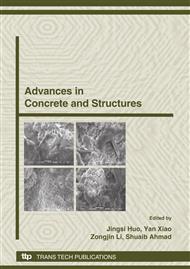p.269
p.275
p.281
p.287
p.295
p.301
p.311
p.321
p.329
Experimental Research and Analysis on the Flexible Behaviors of High-Strength Concrete Thin-Walled Box Girder
Abstract:
A full test on the flexible behaviors of the long flanges and trapezoidal section high-strength concrete thin-walled box girder has been performed. The deflection horizontal distribution, strain and strain distribution of concrete and reinforced bars in the compressive flanges, strain distribution along rib height have been studied. The results demonstrate that reinforced concrete thin-walled box girder has fine flexible behavior and ductility, strain distribution along rib height agrees with the basic assume, i.e. Plane section before deforming remain plane, and the destructive experimental results disclosed the full process law of shear lag effect and equivalent calculated coefficient of compressed flange width at middle span section, which can be served as a reference for that applying elementary reinforced concrete beam theory settles the ultimate flexural capacity calculation of concrete thin-walled box girder.
Info:
Periodical:
Pages:
295-300
Citation:
Online since:
October 2008
Authors:
Price:
Сopyright:
© 2009 Trans Tech Publications Ltd. All Rights Reserved
Share:
Citation:


